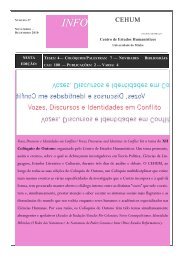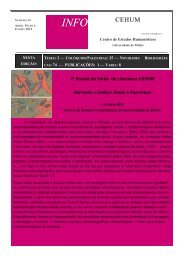A MECÂNICA DO SENTIR – RACIONALIDADE E MIMESIS NA PERFORMANCE MUSICAL 209 –––– (1988), “Generative principles in music performance”, in Sloboda, G. (ed.), Generative Processes in Music, Oxford, Claren<strong>do</strong>n Press, pp. 1 -26. Davidson, J. (1991), Th e perception of expressive movements in performance, Tese de Doutoramento, Londres, City University. –––– (1993), “Visual perception of performance manner in the movements of solo musicians”, Psycology of Music 21, pp. 103 -113. –––– (1999), “O corpo na interpretação musical”, Revista Música, Psicologia e Educação 1, pp. 79 -89. –––– (2008), “Communicating with the body in performance”, in Rink, J. (ed.), Musical Performance: A guide to understanding, Cambridge, Cambridge University Press, pp. 144 -152. Davidson, J. & Dawson, J. C. (1995), “Th e development of expression in body movement during learning in piano performance”, Comunicação à Society for Music Perception and Cognition Conference, Berkely, University of California. Frazier, L. & Fo<strong>do</strong>r, J. D. (1978), “Th e sausage machine: A new two -stage parsing model”, Cognition 6, pp. 291 -3<strong>25</strong>. Friberg, A. & Batel, G. U. (2002), “Structural communication”, in Parncutt, R. & G. McPherson (ed.), Th e science & psychology of music performance. Creative strategies for teaching and learning, Oxford, Oxford University Press, pp. 199 -218. Gabrielsson, A. (1987), “Once again: the theme from Mozart’s Piano Sonata in A major (K. 331). A comparison of fi ve performances”, in Gabrielson, A. (ed.): Action and Perception in Rhythm and Music, Stockholm, Publication issued by the Royal Swedish Academy of Music, No. 55, pp. 81 -103. –––– (2001), “Emotions in strong experiences with music”, in P.N. Juslin & J.A. Sloboda (eds.), Music and emotion: Th eory and research, Oxford, Oxford University Press, pp. 431 -449. –––– (2006), “Strong experiences elicited by music – What music? “, in Locher, P., Martindale, C. & L. Dorfman (Eds.), New Directions in Aesthetics, Creativity, and the Arts, NY, Baywood Publishing Company Inc., pp. <strong>25</strong>1 -267. Gabrielsson, A. & Lindström, S. (1995), “Can strong experiences of music have therapeutic implications?”, in Steinberg, R. (ed.), Music and the mind machine, Berlin, Springer -Verlag, pp. 195 -202. –––– (2000), “Strong experiences of and with music”, in Greer, D. (ed.), Musicology and Sister Disciplines. Past, Present, Future, Oxford, Oxford University Press, pp.100 -8. –––– (2003), “Strong experiences related to music: A descriptive system”, Musicae Scientiae 7, pp. 157 -217. Goldstein, A. (1980), “Th rills in response to music and other stimuli”, Physiological Psychology 8, 126–129. <strong>Diacritica</strong> <strong>25</strong>-2_<strong>Filosofia</strong>.<strong>indb</strong> 209 05-01-2012 09:38:30
210 ÂNGELO MARTINGO Grewe, O., Kopiez, R. & Altenmuller, E. (2009), “Chills As an Indicator of Individual Emotional Peaks. Th e Neurosciences and MusicIII: Disorders and Plasticity”, Ann. N. Y. Acad. Sci. 1169, pp. 351–354. Hong, S. (2006), “Peak experience in music: A case study between listeners and performers”, in Baroni, M., Addessi, A. R., Caterina, R. & M. Costa (Eds.), Proceedings of the 9th International Conference on Music Perception and Cognition, Bologna, Alma Matter Studiorum University of Bologna, pp. 1176 -1182. Jacken<strong>do</strong>ff, R. (1992), “Musical processing and musical aff ect”, in Jones, M. & S. Holleran (Ed.): Cognitive basis of musical communication, Washington, American Psychological Association, pp. 51 -68. Juslin, P. N., & Zentner, M. (2002), “Current trends in the study of music and emotion: Overture”, Musicae Scientiae, Special Issue, 2001 -2002, pp. 3 -21 Krumhansl, K. (1996). A perceptual analysis of Mozart’s Piano Sonata K.282: Segmentation, tension, and musical ideas. Music Perception, 13: 401 -432. –––– (2003), “Music and aff ect: Empirical and theoretical contributions from experimental psychology”, in Greer, D. (ed.), Musicology and sister disciplines, Past, present, future, Oxford, Oxford University Press, pp. 88 -99. Lamont. A. (2009), “Strong Experiences of Music in University Students”, in Louhivuori, J., Eerola, T., Saarikallio, S., Himberg, T. & Päivi -Sisko Eerola (Eds.), Proceedings of the 7th Triennial Conference of European Society for the Cognitive Sciences of Music, Jyväskylä, ESCOM, pp. <strong>25</strong>0 -<strong>25</strong>9. Lerdahl, F. & Jacken<strong>do</strong>ff, R. (1983), A generative theory of tonal music, Cambridge, MA, MIT Press. Lerdahl, F. (2001), Tonal pitch space, Oxford, Oxford University Press. Lowis, M. J. (1998), “Music and peak experience: an empirical study”, Mankind Quarterly 32, pp. 203 -2<strong>25</strong>. –––– (2002), “Music as a Trigger for Peak experiences among a college staff s population”, Creativity Research Journal 14, pp. 351 -359. Marcus, M. (1980), A theory of syntactic recognition for natural language, Cambridge, MA, MIT Press. Martingo, A. (2006), “Testing Lerdahl’s tonal space theory – Performed expressive deviations and listener’s preferences”, in Baroni, R., A. Addessi & M. Costa (eds.), Proceedings of the 9th International Conference on Music Perception & Cognition (ICMPC9), Bolonha, SMPC/ESCOM, pp. 560 -561. –––– (2007a), “Making sense out of taste: Listener’s preferences of performed tonal music”, in Williamon, A. & D. Coimbra (eds.), Proceedings of the International Simposium of Performance Science, Porto, Casa da Música, pp. 245 -<strong>25</strong>0. <strong>Diacritica</strong> <strong>25</strong>-2_<strong>Filosofia</strong>.<strong>indb</strong> 210 05-01-2012 09:38:30
- Page 1 and 2:
25/2 revista do centro de estudos h
- Page 3 and 4:
Título: DIACRÍTICA (Nº 25/2 - 20
- Page 5 and 6:
CULTURA INGLESA E NORTE-AMERICANA 1
- Page 7 and 8:
Diacritica 25-2_Filosofia.indb 6 05
- Page 9 and 10:
Diacritica 25-2_Filosofia.indb 8 05
- Page 11 and 12:
10 ALEXANDRA ABRANCHES E ROBERTO ME
- Page 13 and 14:
Diacritica 25-2_Filosofia.indb 12 0
- Page 15 and 16:
14 Introduction BERIL SÖZMEN IDEME
- Page 17 and 18:
16 BERIL SÖZMEN IDEMEN When a fema
- Page 19 and 20:
18 BERIL SÖZMEN IDEMEN example, Th
- Page 21 and 22:
20 BERIL SÖZMEN IDEMEN doubt wheth
- Page 23 and 24:
22 BERIL SÖZMEN IDEMEN Th omson’
- Page 25 and 26:
24 BERIL SÖZMEN IDEMEN If we are t
- Page 27 and 28:
26 BERIL SÖZMEN IDEMEN respect, es
- Page 29 and 30:
28 BERIL SÖZMEN IDEMEN choices tha
- Page 31 and 32:
30 BERIL SÖZMEN IDEMEN Good Samari
- Page 33 and 34:
Diacritica 25-2_Filosofia.indb 32 0
- Page 35 and 36:
34 1. Introdução CÁTIA FARIA No
- Page 37 and 38:
36 CÁTIA FARIA Deste modo, chegamo
- Page 39 and 40:
38 CÁTIA FARIA e os orangotangos e
- Page 41 and 42:
40 CÁTIA FARIA temporal, quando no
- Page 43 and 44:
42 CÁTIA FARIA mesmo. “Sem um se
- Page 45 and 46:
44 CÁTIA FARIA soas são seres esp
- Page 47 and 48:
46 CÁTIA FARIA David não é ele p
- Page 49 and 50:
48 7. Resumo e conclusões CÁTIA F
- Page 51 and 52:
50 CÁTIA FARIA Patterson, F. G. e
- Page 53 and 54:
52 CÉDRIC RIO Debates about Interg
- Page 55 and 56:
54 CÉDRIC RIO we are not sure to h
- Page 57 and 58:
56 CÉDRIC RIO ence: individuals ca
- Page 59 and 60:
58 CÉDRIC RIO morally wrong becaus
- Page 61 and 62:
60 CÉDRIC RIO preference for Liber
- Page 63 and 64:
Diacritica 25-2_Filosofia.indb 62 0
- Page 65 and 66:
64 1. The problem CLAUDIA REITINGER
- Page 67 and 68:
66 CLAUDIA REITINGER Depletion: As
- Page 69 and 70:
68 CLAUDIA REITINGER lates the pers
- Page 71 and 72:
70 CLAUDIA REITINGER responses for
- Page 73 and 74:
72 CLAUDIA REITINGER a very high le
- Page 75 and 76:
74 CLAUDIA REITINGER had chosen con
- Page 77 and 78:
76 CLAUDIA REITINGER properties, li
- Page 79 and 80:
Diacritica 25-2_Filosofia.indb 78 0
- Page 81 and 82:
80 HASSE HÄMÄLÄINEN que actualme
- Page 83 and 84:
82 HASSE HÄMÄLÄINEN appropriate
- Page 85 and 86:
84 HASSE HÄMÄLÄINEN son cannot b
- Page 87 and 88:
86 HASSE HÄMÄLÄINEN than charact
- Page 89 and 90:
88 HASSE HÄMÄLÄINEN lence” and
- Page 91 and 92:
90 5. A more promising proposal HAS
- Page 93 and 94:
92 HASSE HÄMÄLÄINEN this particu
- Page 95 and 96:
Diacritica 25-2_Filosofia.indb 94 0
- Page 97 and 98:
96 MARIA JOÃO CABRITA e o seu rele
- Page 99 and 100:
98 MARIA JOÃO CABRITA a legal ethi
- Page 101 and 102:
100 MARIA JOÃO CABRITA - the inter
- Page 103 and 104:
102 MARIA JOÃO CABRITA justice, in
- Page 105 and 106:
104 MARIA JOÃO CABRITA Rawls seeks
- Page 107 and 108:
106 MARIA JOÃO CABRITA members of
- Page 109 and 110:
108 MARIA JOÃO CABRITA Spiro, Davi
- Page 111 and 112:
110 MARTHA PALACIO AVENDAÑO El obj
- Page 113 and 114:
112 MARTHA PALACIO AVENDAÑO de reg
- Page 115 and 116:
114 2. Cosmopolitismo y derechos hu
- Page 117 and 118:
116 MARTHA PALACIO AVENDAÑO societ
- Page 119 and 120:
118 MARTHA PALACIO AVENDAÑO lo que
- Page 121 and 122:
120 MARTHA PALACIO AVENDAÑO poder
- Page 123 and 124:
122 MARTHA PALACIO AVENDAÑO 126, 2
- Page 125 and 126:
Diacritica 25-2_Filosofia.indb 124
- Page 127 and 128:
126 1. Intransitive preferences OSC
- Page 129 and 130:
128 A 1 > 1 A 2 ; A 2 > 1 A 3 ; ...
- Page 131 and 132:
130 OSCAR HORTA principle obvious.
- Page 133 and 134:
132 5. Possible global solutions to
- Page 135 and 136:
134 OSCAR HORTA between 1 and i suc
- Page 137 and 138:
136 OSCAR HORTA considerably shorte
- Page 139 and 140:
138 7. Conclusions OSCAR HORTA Spec
- Page 141 and 142:
Diacritica 25-2_Filosofia.indb 140
- Page 143 and 144:
142 RUI SILVA inclinations […]; f
- Page 145 and 146:
144 RUI SILVA ble diversity of situ
- Page 147 and 148:
146 RUI SILVA and complement these
- Page 149 and 150:
148 RUI SILVA emotions and virtue;
- Page 151 and 152:
150 RUI SILVA lives should be under
- Page 153 and 154:
152 RUI SILVA However, MacIntyre cl
- Page 155 and 156:
154 RUI SILVA alists concede that s
- Page 157 and 158:
156 RUI SILVA Taylor, Charles (1990
- Page 159 and 160: Diacritica 25-2_Filosofia.indb 158
- Page 161 and 162: 160 GEORGINA ABREU Th e print cultu
- Page 163 and 164: 162 GEORGINA ABREU that the prosecu
- Page 165 and 166: 164 GEORGINA ABREU stability of the
- Page 167 and 168: 166 GEORGINA ABREU gled out and exp
- Page 169 and 170: 168 GEORGINA ABREU ways. Th is disc
- Page 171 and 172: 170 GEORGINA ABREU Queen’s case:
- Page 173 and 174: 172 GEORGINA ABREU From the point o
- Page 175 and 176: 174 GEORGINA ABREU 1998: 38) that g
- Page 177 and 178: 176 GEORGINA ABREU denounces the co
- Page 179 and 180: 178 GEORGINA ABREU i-ii). Hone, in
- Page 181 and 182: 180 Periodicals GEORGINA ABREU Cobb
- Page 183 and 184: 182 GEORGINA ABREU 1819-1821 Illust
- Page 185 and 186: 184 GEORGINA ABREU Laqueur, T.W.,
- Page 187 and 188: 186 JORGE PEREIRA A Revolução Ame
- Page 189 and 190: 188 JORGE PEREIRA concebidos para e
- Page 191 and 192: 190 JORGE PEREIRA proposta de aboli
- Page 193 and 194: 192 JORGE PEREIRA permitia a todos
- Page 195 and 196: 194 JORGE PEREIRA agora era o Indiv
- Page 197 and 198: 196 JORGE PEREIRA moral já que qua
- Page 199 and 200: 198 JORGE PEREIRA sistas têm defen
- Page 201 and 202: 200 JORGE PEREIRA Homem, daí estar
- Page 203 and 204: Diacritica 25-2_Filosofia.indb 202
- Page 205 and 206: 204 Recepção musical como mimesis
- Page 207 and 208: 206 ÂNGELO MARTINGO agógicos dos
- Page 209: 208 Sumário e conclusão ÂNGELO M
- Page 213 and 214: 212 ÂNGELO MARTINGO Tanenhaus, M.,
- Page 215 and 216: 214 1. Críticas e objeções aos d
- Page 217 and 218: 216 GIUSEPPE TOSI dade das relaçõ
- Page 219 and 220: 218 GIUSEPPE TOSI ocidentais atrav
- Page 221 and 222: 220 GIUSEPPE TOSI Francesa (Compara
- Page 223 and 224: 222 GIUSEPPE TOSI ciências naturai
- Page 225 and 226: 224 GIUSEPPE TOSI que a realidade
- Page 227 and 228: 226 GIUSEPPE TOSI -----, (2006). Te
- Page 229 and 230: 228 I. O argumento JOSÉ COLEN Buch
- Page 231 and 232: 230 JOSÉ COLEN tica numa situaçã
- Page 233 and 234: 232 JOSÉ COLEN mas as outras impli
- Page 235 and 236: 234 JOSÉ COLEN “que modifi cam o
- Page 237 and 238: 236 JOSÉ COLEN unidade orgânica p
- Page 239 and 240: 238 JOSÉ COLEN que a respectiva
- Page 241 and 242: 240 JOSÉ COLEN Um dos fenómenos p
- Page 243 and 244: 242 JOSÉ COLEN Hayek deixou claro
- Page 245 and 246: 244 JOSÉ COLEN rias nos domínios
- Page 247 and 248: 246 JOSÉ COLEN no mercado a motiva
- Page 249 and 250: 248 JOSÉ COLEN Mueller, Dennis C.
- Page 251 and 252: 250 1. Introdução VÍTOR MOURA O
- Page 253 and 254: 252 VÍTOR MOURA phrey Bogart para
- Page 255 and 256: 254 VÍTOR MOURA que o cinema vive
- Page 257 and 258: 256 2) 3) VÍTOR MOURA Redução da
- Page 259 and 260: 258 VÍTOR MOURA fílmica (a vulgar
- Page 261 and 262:
260 3. Câmara: a doutrina da trans
- Page 263 and 264:
262 VÍTOR MOURA máticas dos objec
- Page 265 and 266:
264 VÍTOR MOURA “A fotografi a
- Page 267 and 268:
266 VÍTOR MOURA representações d
- Page 269 and 270:
268 VÍTOR MOURA podemos explicar a
- Page 271 and 272:
270 VÍTOR MOURA Em resumo, poderí
- Page 273 and 274:
272 4.3. Teoria da mente e simulaç
- Page 275 and 276:
274 VÍTOR MOURA ninguém acredita
- Page 277 and 278:
Diacritica 25-2_Filosofia.indb 276
- Page 279 and 280:
Diacritica 25-2_Filosofia.indb 278
- Page 281 and 282:
280 VIRGÍNIA SOARES PEREIRA Gaio V
- Page 283 and 284:
Diacritica 25-2_Filosofia.indb 282
- Page 285 and 286:
284 VIRGÍNIA SOARES PEREIRA No pre
- Page 287 and 288:
Diacritica 25-2_Filosofia.indb 286
- Page 289 and 290:
288 Editor Adjunto: Virgínia Perei
- Page 291 and 292:
290 DIACRÍTICA 3. Os textos das en
- Page 293 and 294:
292 • • • • Imagens Alinham
- Page 295 and 296:
294 Citação indireta: (apud Chand
- Page 297:
The Braga meetings on ethics and po


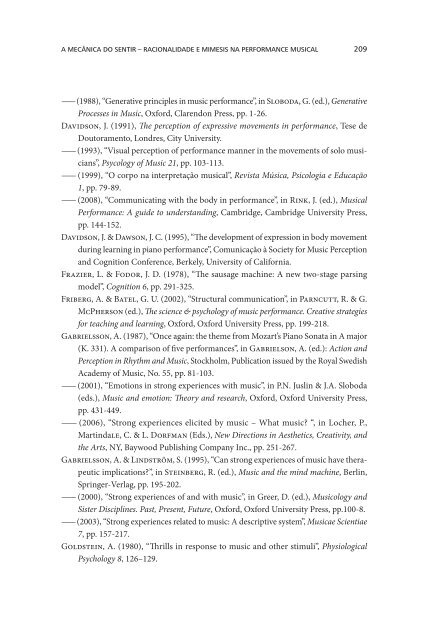
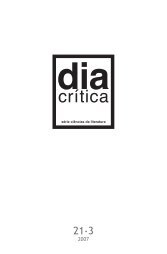

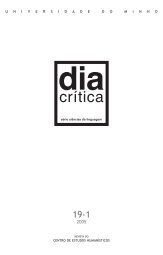



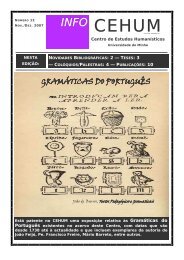

![Programa [pdf] - cehum - Universidade do Minho](https://img.yumpu.com/17305425/1/190x135/programa-pdf-cehum-universidade-do-minho.jpg?quality=85)


